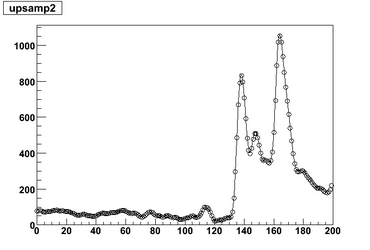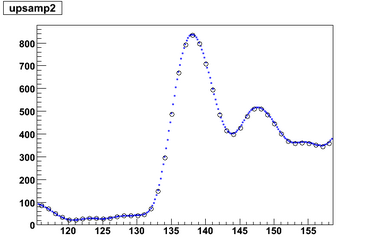CDC algo
Contents
CDC time & integral algorithm
We will need to arrange the trigger timing so that when the trigger signal arrives, the presample buffer contains a number of samples for pedestal followed by the earliest possible CDC sample and then another 155 samples (for maximum drift time).
Quantities to be returned, if a hit is found
- Leading edge time (11 bits, units of sample/10)
- Time quality Factor (1 bit) set to 0 if time is good, 1 if time is rough estimate
- Pedestal immediately before the hit (8 bits, set to 255 if >254)
- Signal integral (n bits, scaled down by factor 2^m, n,m approx 14,4, TBC)
- Overflow count (3 bits, set to 7 if >6)
- Signal maximum (x bits, scaled down by factor 2^y; x,y approx 9,3, TBC) this is the first maximum in the signal after the threshold crossing
Configuration constants (all values are integers, σ=pedestal width ~16)
- window_start: start of hit search window as sample number relative to the trigger arrival, this is the earliest possible hit time
- window_end: end of hit search window as sample number relative to the trigger arrival, approx 155 samples after window_start
- hit_threshold: threshold to identify hit (default 5σ ~80, range 50 to 300)
- high_threshold: High timing threshold (default 4σ ~ 64, range 40 to 270) must be lower than hit threshold
- low_threshold: Low timing threshold (default 1σ ~ 16, range 5 to 30)
- nsamples: number of ADC samples to pass to time finding module (default 14)
- xthr_sample: sample number containing first sample (x) above hit_threshold (default 8)
- ped_sample: sample number to be used as local pedestal (default 4)
- rough_dt: if timing fails because ADC values do not exceed high_threshold, return hit time of xthr_sample-rough_dt (default 20, units sample/10)
- integral_offset: number of samples before x to include in integration (default 3).
Hit finding module
- Wake up on trigger
- Calculate start_pedestal as mean of 4 samples window_start-5 to window_start-1
- Search hit signal window for ADC value rising above start_pedestal + hit_threshold at sample x
- Call up time-finding module and send in nsamples ADC values with the threshold-crossing sample x as value xthr_sample in the sequence (starting at 0)
- Call up signal integral module
- Return local_pedestal as value of sample (x + ped_sample - xthr_sample), or 255 if local_pedestal>254
- Return integral and overflow count from integral module
- Return q_code from time module
- Return (x - xthr_sample)*10 + time returned from time module, units are 0.1*sample-period (0.8ns)
Signal integral module
This returns the signal integral and overflow count
- Sum signal, from sample x-integral_offset to sample end_window, and count the number of samples with overflow bit set
- Return integral scaled down by 2^m (return all bits set if value exceeds that of bits available)
- Return overflow count (return 7 if count>6)
Time finding module
This returns an error code q_code and the hit time, relative to the threshold-crossing sample time
- Calculate thresholds from constants and local pedestal sent in as in sample[ped_sample]
- Search from sample[ped_sample+1] to sample[nsamples-1] for sample value > high_threshold + sample[ped_sample]
If this threshold is not exceeded, return bit q_code=1 and time x-
Data-scanning process starts up prompted by trigger signal, reads through ADC value to search for a hit. If a hit is found then it returns a time, sum of signal minus pedestal, and QF (Quality Factor) code. The process is described for one ADC channel, it would be the same process running on all channels. This can be implemented to scan ADC samples initially, but eventually it should use upsampled data.
Hit processing
We are now at the threshold crossing, sample number x where adc value first rises over 'event pedestal' + 'hit_threshold'
- Find time:
- Store value of sample (x-'pedestal_lead') as 'local pedestal'
- Start at sample (x-'pedestal_lead') and search forward to find sample y where adc value rises above 'local pedestal' + 'high_threshold'
- Search back through progressively earlier samples to find sample z where adc value falls below 'local pedestal' + 'low_threshold'
- Calculate leading edge time 'le_time' as value t where straight line through y and z intercepts 'local_pedestal'
- Calculate x-t. if this is greater than 'time_tolerance,' set 'le_time' = x-'time_constant'
- Find integral:
- Return to first sample after 'le_time'
- Calculate the sum of (sample value - 'local pedestal') for the next 'integration_period' samples
- Calculate QF. This contains - as a starting point - a bit set if x-t > 'time_tolerance', and some measure of pedestal, maybe the lowest bits to cover the range 0-511.
- Return time, integral, QF.
Upsampled data


